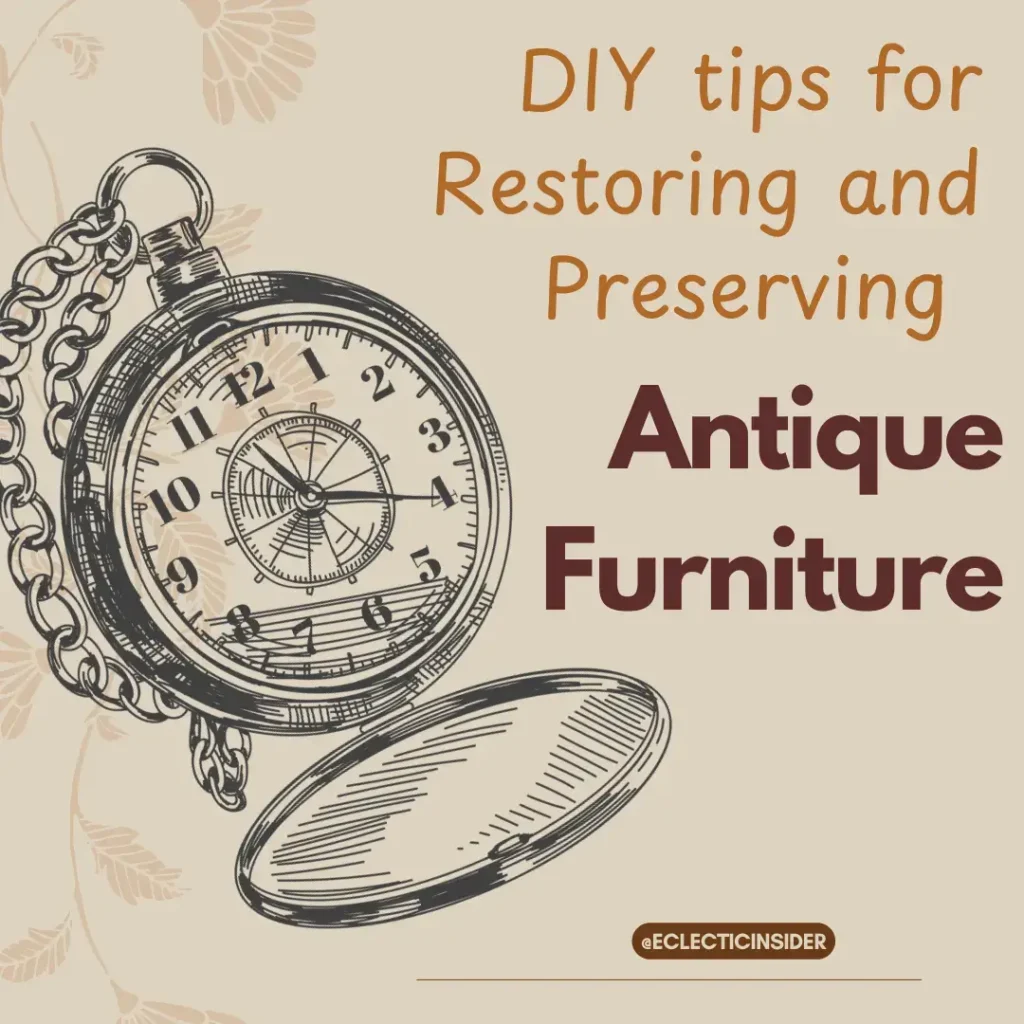Restoring and preserving antique furniture is a rewarding endeavor that allows you to maintain the beauty and value of these cherished pieces.
Whether you’ve inherited a family heirloom or found a vintage gem at a flea market, following these DIY tips can help you bring your antique furniture back to life while preserving its historical charm.

10 Essentials for Antique Furniture Restoration and Preservation
1. Assess the Condition
Before you begin any restoration work, thoroughly inspect the piece. Look for signs of damage such as cracks, scratches, or loose joints.
Determine whether the finish is worn or if the wood has been affected by moisture. Document the condition to guide your restoration process.
2. Clean Carefully
Start by gently cleaning the furniture with a soft, dry cloth to remove dust and debris.
For more stubborn dirt, use a mild solution of water and dish soap applied with a damp cloth. Avoid soaking the wood, as excess moisture can cause damage.
3. Repair Structural Damage
Address any structural issues first. Tighten loose joints with wood glue, clamps, or screws.
For broken parts, use wood filler or epoxy to fill gaps and cracks. Allow repairs to fully dry and set before proceeding.
4. Refinish the Surface
To restore the finish, gently strip old varnish or paint using a chemical stripper or sanding.
Work in a well-ventilated area and follow safety instructions on the product. After stripping, sand the surface smooth using fine-grit sandpaper.
For a natural look, apply a wood conditioner followed by a clear finish like shellac or polyurethane.
5. Recolor and Stain
If you want to change the color or enhance the wood’s appearance, apply a wood stain.
Test the stain on a small, inconspicuous area first to ensure the desired result.
Apply evenly and wipe off excess to achieve a consistent finish. Let it dry completely before sealing.
6. Protect the Finish
Once refinished, protect your furniture with a quality wood polish or wax.
These products not only enhance the shine but also provide a protective layer against moisture and dust.
Apply according to the manufacturer’s instructions and regularly maintain the finish to keep it looking its best.
7. Handle with Care
When moving or handling antique furniture, use protective materials like furniture pads or blankets to avoid scratches and dings.
Always lift furniture with care to prevent stress on joints and legs.
8. Store Properly
Store antique furniture in a climate-controlled environment to prevent damage from temperature fluctuations and humidity.
Avoid direct sunlight, which can cause fading and deterioration of finishes.
Use furniture covers or dust sheets to keep pieces protected when not in use.
9. Consult a Professional
For significant damage or complex restoration projects, consider consulting a professional conservator.
They can provide expert advice and services to ensure that your antique furniture is restored correctly and preserved for future generations.
10. Regular Maintenance
Regular maintenance is key to preserving your antique furniture. Clean gently, check for any signs of damage, and address issues promptly.
By caring for your antiques properly, you ensure they remain beautiful and functional for years to come.
Conclusion
Restoring and preserving antique furniture not only revives the beauty and functionality of these cherished pieces but also honors their historical significance.
By following these DIY tips, you can ensure that your antiques remain in excellent condition for generations to come.
Remember, while DIY restoration can be incredibly rewarding, don’t hesitate to seek professional help for complex issues.
For those looking to enhance their antique collection or find unique additions, check out our list of the 10 Best Antique Items on Amazon in the USA to discover exceptional pieces available online.
Happy restoring!
FAQs
What should I do first when restoring antique furniture?
Assess the condition of the piece, including checking for damage and wear.
How can I clean antique furniture without damaging it?
Use a soft, dry cloth to remove dust. For deeper cleaning, use a mild soap solution and a damp cloth, avoiding excess moisture.
What is the best way to repair loose joints in antique furniture?
Use wood glue or screws to tighten loose joints, and clamps to hold pieces together until the glue dries.
How do I remove old varnish or paint from antique furniture?
Use a chemical stripper or sandpaper. Follow safety instructions carefully and work in a well-ventilated area.
What type of finish should I use on restored antique furniture?
Apply a clear finish like shellac or polyurethane to protect the wood and enhance its natural beauty.
Can I change the color of my antique furniture?
Yes, you can apply wood stain to change or enhance the color, but always test on a small area first.
How do I protect the finish of my antique furniture?
Use wood polish or wax regularly to maintain the finish and provide protection against dust and moisture.
What are the best practices for storing antique furniture?
Store in a climate-controlled environment, away from direct sunlight and humidity. Use furniture covers to protect against dust.
When should I seek professional help for restoring antique furniture?
Consult a professional for significant damage or complex restorations that require specialized skills.
How often should I perform maintenance on my antique furniture?
Regularly clean and inspect for damage. Address any issues promptly to ensure long-term preservation.





